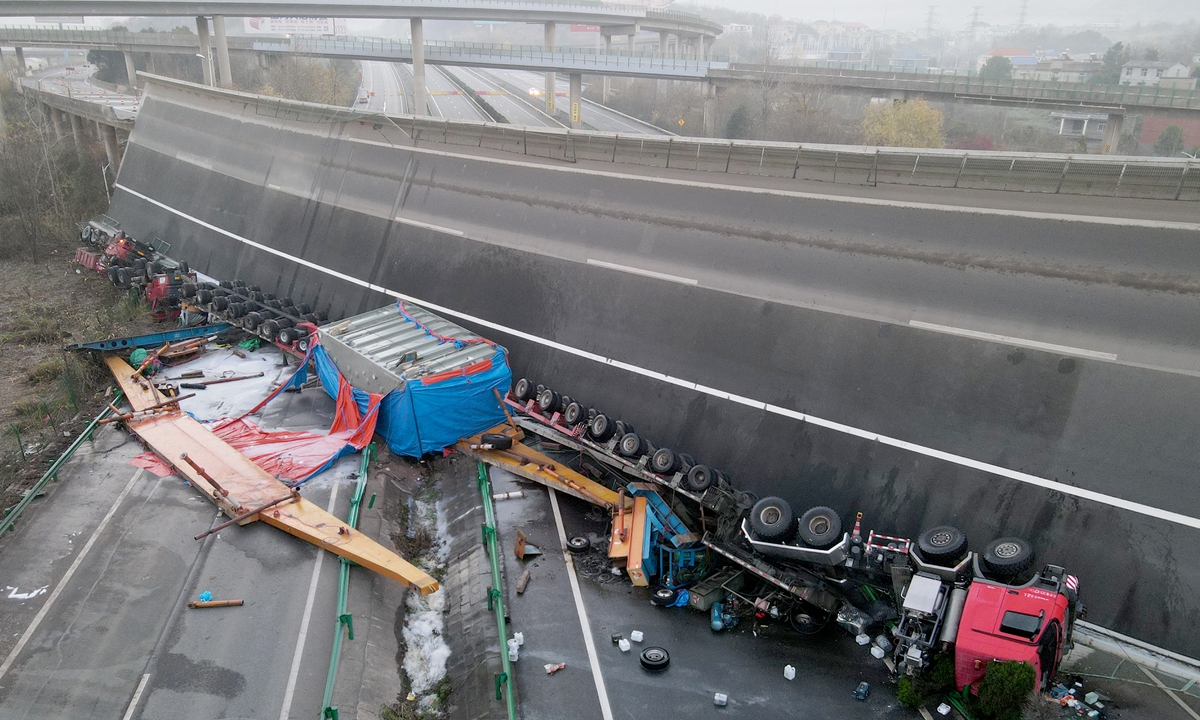4 dead, 8 injured in ramp bridge tilt in C.China’s Hubei, allegedly due to serious overloading

Four people died and eight others were injured in a highway bridge collapse in Ezhou, Central China's Hubei Province, on December 19, 2021. Photo: VCG
Four people died and eight others were injured in a highway bridge collapse in Ezhou, Central China's Hubei Province, where serious overloading was reportedly to be the cause, as the load of one of the trucks running on the bridge surpassed the weight limit nearly three times.
In response, experts said that the authorities should raise the standards for bridge safety due to worsening overloading problems.
The accident took place on Saturday afternoon when a 500-meter-long ramp overpass tilted to one side at nearly 90 degrees, crushing one car, which ran along the expressway under the bridge. Three trucks - belonging to the same transport team based in North China's Tianjin Municipality - moving in the same direction on the bridge fell off.
A man surnamed Wang who drove the car that was crushed by the bridge said he and his two friends broke the back window and escaped after the ramp suddenly hit the front, cqcb.com reported on Sunday.
"Three minutes later, the tilted bridge slid and squashed the car. My friends and I were so close to death," said Wang.
An investigation is underway. A person surnamed Xiong who is in charge of the transport team is cooperating in the investigation and will take responsibility for the tragedy.
Song Jianjun, a person in charge of the Hubei Edong Yangtze River Bridge Corp, believes a serious overloading problem was possibly the main cause, cqcb.com reported.
One of the fallen trucks weighs 198 tons, which is nearly four times the bridge's maximum weight of 49 tons, said Song.
Li Faxiong, a researcher at the Research Institute of Highways at the Ministry of Transport, told the Global Times on Sunday that the tragedy happened either because of the truck or the overpass.
"The truck clearly broke the regulations, for it didn't leave the highway at the toll station it was supposed to. The tilt of the overpass doesn't mean that its design or construction didn't meet the standards or regulations, but it indicates that the weight of the 198-ton truck surpassed its safety redundancy - its initial design goal on safety," emphasized Li.
According to Li, Chinese transportation authorities have been considering a rise in the safety redundancy of bridges to prevent similar accidents.
The increasing number of overloaded cars is forcing transport agencies in multiple places to reinforce bridges, although these bridges were designed and built in accordance with laws and regulations, Li added.
The bridge had only one single-column pier. Experts told the media that such a type of bridge is very prone to collapse, especially when many vehicles are moving on the same side.
Xiong told the media that the bridge was under maintenance when the truck passed. The workers told the drivers not to move into the middle of the bridge.
"The overloaded truck went onto the highway on Tuesday from the toll station in Lintong, Northwest China's Shaanxi Province, where it was to have been examined," Song said.
The Lintong toll station said that the overloaded truck had passed the check at the station with the approval of the transport agencies for carrying goods surpassing the required weight or size, the Beijing News reported on Sunday.
According to the approval, which was given by the Shaanxi Highway Bureau, the truck weighs 198 tons and it belongs to Tianjin Pingfa Large Transport Corp. It was allowed to get onto the G30 Lianhuo Highway from the Lintong toll station and get off at the Qindong toll station in Shaanxi.
But the truck didn't leave the G30 Lianhuo Highway, which runs through Shaanxi, Hubei and Central China's Henan, at the Qindong toll station. It kept moving toward the direction of Henan and managed to arrive in Hubei without inspection since toll stations had been closed at the border between the different provinces, The Paper reported on Sunday.
The Tianjin Pingfa Large Transport Corp did not explain why the truck didn't leave the highway at the Qindong toll station.
The station has sent the data to the traffic department of Hubei, saying that the possibility cannot be ruled out that the truck falsified data to pass the station check.
The transport departments in Hubei and Shaanxi are investigating the case.
Overloading and speeding have been found to be the causes of many accidents, including bridge and road collapses and car accidents, in recent years.
For example, a viaduct in Wuxi, East China's Jiangsu Province, collapsed in October 2019, killing three people. The accident was caused by an overloaded truck, Wuxi authorities announced.
